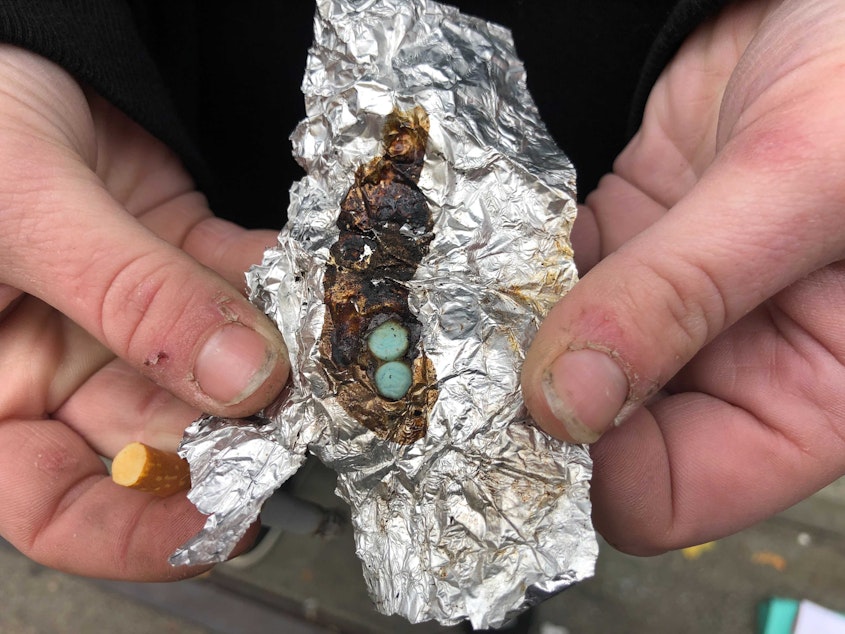Washington overdose deaths continued to rise in 2023 while national trends declined, but there's hope

Overdose deaths in Washington state continued to rise throughout 2023, bucking the national trend. According to preliminary data released by the Centers for Disease Control and Prevention this week, reported overdose deaths across the U.S. fell by roughly 5% in 2023, compared to 2022.
In contrast, Washington state saw an increase in reported overdose fatalities of roughly 25% over that same period. It’s the second highest increase in any state in the country, behind Alaska. That represents 3,437 lives lost in 2023.
The CDC report is based on numbers that are underreported due to incomplete data sets. The report also provides predicted numbers based on what's expected from a full data set.
Predicted numbers show a slightly smaller dip in deaths across the U.S., and a slightly larger increase in deaths in Washington.
RELATED: More than 16K people are experiencing homelessness in King County, up from 2022
In many other states, particularly on the East Coast, fatalities declined year over year, contributing to the overall downward trend nationally.
Sponsored
Brad Finegood is a strategic advisor with Public Health – Seattle & King County. He said the national trend is great to see, and there are reasons Washington’s numbers are going in the opposite direction.
“We’ve always seen regional differences in drug supply and overdose deaths in different areas around the country,” Finegood said.
He said the continued increase in Washington's deaths last year likely says something about historic, and current, drug distribution routes. Finegood also said timing is a contributing factor.
“One of the things we do know is that fentanyl was really late to come to the Northwest,” he said.
Finegood said the East Coast was hit harder earlier than places like Washington.
Sponsored
Despite the continued year-over-year increase in deaths, Finegood said there are glimmers of hope in local numbers.
In King County, the number of overdose fatalities by quarter fell in the final three months of 2023, and there was another decrease in the first quarter of 2024.
July through September of 2023 was the most fatal three month period the county has seen. In that window, 359 people died from an overdose in the county, the vast majority being fentanyl-related deaths. The following quarter saw slightly fewer deaths.
The first three months of 2024 saw another quarter-over-quarter decrease, but 293 people still died.
“There are signs that we are sort of following the curve, and maybe just a little bit delayed in that,” Finegood said.
Sponsored
He said this doesn’t indicate that there’s been a peak and now deaths will fall to zero, and there’s a lot of work left to do. But he said there’s a clear path charted out, and some of that includes interventions that will take some time.
RELATED: Seattle will soon have a place for people to go after surviving an overdose
Like other areas of the country, Washington state, King County, and Seattle are putting in place interventions intended to keep people alive, help them improve their health, and disrupt the cycle of deaths. Things like increased access to treatment, evolutions in the medications that are available, widespread access to overdose reversal drugs, and the announcement of a new post-overdose recovery center.
Finegood said these are some of the things that give him hope.
“Being able to integrate all of these systems so people will be able to get access to evidence-based care wherever they go, I think really makes me look forward to us having a fighting chance for the next couple of years,” he said.
Sponsored
But there's much more that's needed. Many people experiencing substance use disorder are also experiencing homelessness. A recently released report from the University of Washington's Addiction, Drug and Alcohol Institute showed housing was identified as a crucial and substantial need among people surveyed at syringe service programs.
Racial disparities also continue to exist with communities of color experiencing disproportionately high death rates.
In King County, American Indian/Alaska Natives have the highest death rate, despite being a small portion of the county's population.
One solution lies in offering culturally attuned care.
This is something the Seattle Indian Health Board has baked into its approach, and something the organization is looking to expand with a new treatment facility planned for Vashon Island.
Sponsored
The space will have a treatment model centered on traditional Indian medicine. It will provide access to all kinds of care, including medication treatment for opioid use disorder and mental health services.
The site will also serve pregnant and parenting people, providing care and space for kids. It will also have a ceremonial space.
"You'll have access to outdoor space, ceremonial space, we'll have smart screens in there where we can do telemedicine with healers from all over the world," said Esther Lucero, president and CEO of Seattle Indian Health Board.
Lucero spoke to the King County Board of Health Thursday afternoon. She said the Thunderbird Treatment Center is slated to open early next year.
Lucero stressed that support from health leaders in the county will be crucial.
"Everyone wants a solution to the problem until it's in your backyard," she said. "So we're really going to need the support of the Board of Health to help us bring this project to fruition and, more importantly, on time."
Lucero said the new space would vastly increase access to treatment in the state.

